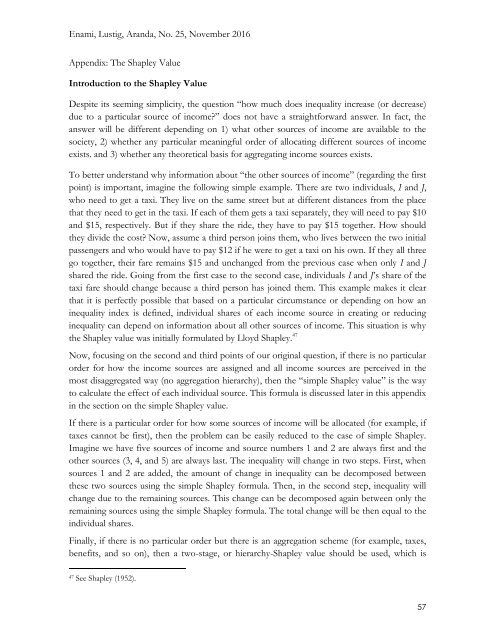IMPACT OF TAXES AND TRANSFERS
n?u=RePEc:tul:ceqwps:25&r=lam
n?u=RePEc:tul:ceqwps:25&r=lam
You also want an ePaper? Increase the reach of your titles
YUMPU automatically turns print PDFs into web optimized ePapers that Google loves.
Enami, Lustig, Aranda, No. 25, November 2016<br />
Appendix: The Shapley Value<br />
Introduction to the Shapley Value<br />
Despite its seeming simplicity, the question “how much does inequality increase (or decrease)<br />
due to a particular source of income?” does not have a straightforward answer. In fact, the<br />
answer will be different depending on 1) what other sources of income are available to the<br />
society, 2) whether any particular meaningful order of allocating different sources of income<br />
exists. and 3) whether any theoretical basis for aggregating income sources exists.<br />
To better understand why information about “the other sources of income” (regarding the first<br />
point) is important, imagine the following simple example. There are two individuals, I and J,<br />
who need to get a taxi. They live on the same street but at different distances from the place<br />
that they need to get in the taxi. If each of them gets a taxi separately, they will need to pay $10<br />
and $15, respectively. But if they share the ride, they have to pay $15 together. How should<br />
they divide the cost? Now, assume a third person joins them, who lives between the two initial<br />
passengers and who would have to pay $12 if he were to get a taxi on his own. If they all three<br />
go together, their fare remains $15 and unchanged from the previous case when only I and J<br />
shared the ride. Going from the first case to the second case, individuals I and J’s share of the<br />
taxi fare should change because a third person has joined them. This example makes it clear<br />
that it is perfectly possible that based on a particular circumstance or depending on how an<br />
inequality index is defined, individual shares of each income source in creating or reducing<br />
inequality can depend on information about all other sources of income. This situation is why<br />
the Shapley value was initially formulated by Lloyd Shapley. 47<br />
Now, focusing on the second and third points of our original question, if there is no particular<br />
order for how the income sources are assigned and all income sources are perceived in the<br />
most disaggregated way (no aggregation hierarchy), then the “simple Shapley value” is the way<br />
to calculate the effect of each individual source. This formula is discussed later in this appendix<br />
in the section on the simple Shapley value.<br />
If there is a particular order for how some sources of income will be allocated (for example, if<br />
taxes cannot be first), then the problem can be easily reduced to the case of simple Shapley.<br />
Imagine we have five sources of income and source numbers 1 and 2 are always first and the<br />
other sources (3, 4, and 5) are always last. The inequality will change in two steps. First, when<br />
sources 1 and 2 are added, the amount of change in inequality can be decomposed between<br />
these two sources using the simple Shapley formula. Then, in the second step, inequality will<br />
change due to the remaining sources. This change can be decomposed again between only the<br />
remaining sources using the simple Shapley formula. The total change will be then equal to the<br />
individual shares.<br />
Finally, if there is no particular order but there is an aggregation scheme (for example, taxes,<br />
benefits, and so on), then a two-stage, or hierarchy-Shapley value should be used, which is<br />
47 See Shapley (1952).<br />
57



